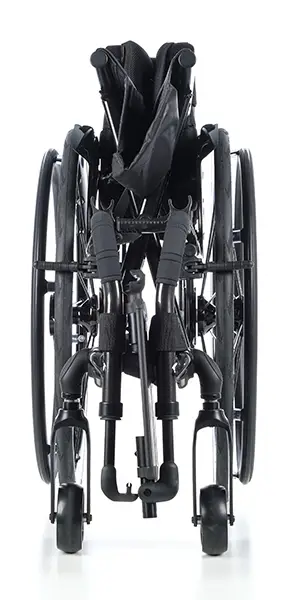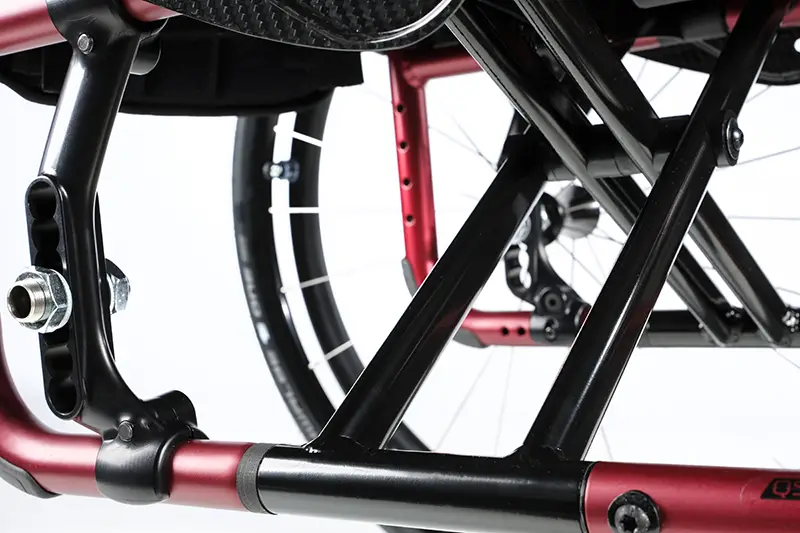Why consider a folding frame wheelchair?
Rigid frame wheelchairs get a lot of attention compared to folding frame chairs. Their clean structure with fewer parts makes them an attractive option for new designs. The absence of a folding mechanism allows pushing forces to transmit more directly to wheelchair movement without being lost in the flex of moving parts. This responsive performance allows them to dominate competitive sports.
However, reality often demands a folding wheelchair frame. Although rigid chairs can be collapsed into relatively small packages by removing the wheels or folding down the back, a traditional "X" type folding frame remains the narrowest and quickest option for wheelchair storage. Folding frame wheelchairs can squeeze into slots in small urban apartments and scissor into a public transport wheelchair space in less than a second. Folding frame wheelchairs have the capability to load automatically into a car top carrier, enabling many drivers who have difficulty lifting a rigid frame to remain fully independent without having to buy an alternative vehicle. Even for rigid or power wheelchair users, a second folding manual wheelchair can be useful for travel or as a base for some powered add-on devices.

Development
Fortunately, more advanced technology is now available for folding wheelchair riders, too. One of the biggest innovations since the original folding wheelchair has been the invention of "rigid folding" wheelchairs. These chairs (such as the QUICKIE QS5 X) use an "X" style side folding frame in which the seat rails lock inside of the side frame, significantly reducing frame flex for a stiff, rigid-like feel. They can have the same advanced componentry and material options as other high-spec chairs with rigid frames such as aerospace-grade aluminum or even carbon fiber. The folding mechanism itself has also improved over time. High-level modern folding wheelchairs are now available with increased folding ease, lighter weight, and more reliable locking in their open position.

Considerations for active folding wheelchairs
For clinicians, asking a few questions can help make the right match between technology options and client requirements. There are several aspects to take into consideration when looking at active rider folding wheelchairs.
Kinematics
How does the chair move through the folding mechanism? Is the fold easy to do, or does it collapse into a V shape which chatters along the ground when trying to fold? Does the person using the chair have to wrestle it into the open and locked position? Does it snap securely into the frame receivers when open? Smooth kinematics reduce the effort to fold and unfold a wheelchair during the day, resulting in more overall energy for daily activities and independence in transfers.
Weight
What is the overall system weight, the lifting weight, and the weight on the front? While configuration has a bigger influence on ease of use than weight, wheelchair weight still influences ease of propulsion.1 Lifting weight can make the difference between doing an activity or avoiding due to the energy/pain/difficulty involved. Front weight in particular influences how easy the chair is to maneuver over small obstacles like thresholds and pavement cracks.2
Materials and engineering
Some materials allow for a lighter, stiffer package. For example, 7000 series aluminum used in high-level rigid wheelchairs has a higher strength-to-weight ratio than the 6000 series. Techniques like forging (molding compressed metal) can add density for strength while maintaining light weight at the caster housing.3
Stiffness
How rigid does the wheelchair feel while propelling? Has technology been used to create more responsiveness in a frame design prone to flex? For example, Sunrise Medical's QUICKIE QS5 X has ovalized tubing in the cross brace, allowing an extra tube to add more rigidity at a reduced weight compared to earlier models in this class.
Components for daily activities
Are there advanced components like tires, ergonomic handrims, wheels, and casters from higher spec chairs? Is the chair easy to grip when lifting and are there options to protect the frame from scratching? Options like lights can increase visibility and allow independence at night while keeping hands free for propulsion.
Although folding frames have been around for nearly a century, modern folding wheelchairs are a different beast altogether. A folding wheelchair is no longer the compromise it once was. Design advancements offer a range of technologies for active clients, from a balance of affordability and performance to the highest performance wheelchairs which rival their rigid counterparts.
References
- Cowan, R. E., Nash, M. S., Collinger, J. L., Koontz, A. M., & Boninger, M. L. (2009). Impact of surface type, wheelchair weight, and axle position on wheelchair propulsion by novice older adults. Archives of physical medicine and rehabilitation, 90(7), 1076-1083.
- Worobey, L. A., Bernstein, J., Ott, J., Berner, T., Black, J., Cabarle, M., ... & Betz, K. (2023). RESNA position on the application of ultralight manual wheelchairs. Assistive Technology, 1-18.
- Saha, P. K. (2000). Aluminum extrusion technology. Asm International.
Faith Brown is an HCPC-registered occupational therapist with over 20 years of international experience in the field of seating and mobility including the British National Health Service, as well as the private and NGO sectors. She has worked with all ages and levels of complexity, including leading an NHS special seating division. She is a research champion for the Royal College of Occupational Therapists and has a history of lifelong professional development. Her post-qualification education includes a postgraduate certificate in Postural Management for People with Complex Disabilities from Oxford Brookes University, an MSc in Health Research Methods from the University of Birmingham (UK) and completion of an engineering module in wheelchair design at the University of San Francisco.